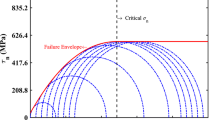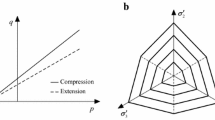Abstract
The failure criterion of rocks is a critical factor involved in reliability design and stability analysis of geotechnical engineering. In order to accurately evaluate the triaxial compressive strength of rocks under different confining pressures, a nonlinear empirical strength criterion based on Mohr-Coulomb criterion was proposed in this paper. Through the analysis of triaxial test strength of 11 types of rock materials, the feasibility and validity of proposed criterion was discussed. For a further verification, six typical strength criteria were selected, and the prediction results of each criterion and test results were statistically analyzed. The comparative comparison results show that the prediction results obtained by applying this new criterion to 97 conventional triaxial compression tests of 11 different rock materials are highly consistent with the experimental data. Statistical analysis was executed to assess the application of the new criterion and other classical criteria in predicting the failure behavior of rock. This proposed empirical criterion provides a new reference and method for the determination of triaxial compressive strength of rock materials.
摘要
岩石的破坏准则是岩土工程可靠性设计和稳定性分析的关键因素。为了准确地评价不同围压条 件下岩石的三轴抗压强度, 本文提出了一种基于莫尔-库仑准则的非线性经验强度准则。通过分析11 种岩石材料三轴试验强度, 探讨了所提出准则的可行性和有效性。为进一步验证, 选取了6 个典型强 度准则, 并对各准则的预测结果和试验结果进行对比分析。对比结果表明, 应用本文提出的准则对11 种不同岩石材料进行97 个常规三轴压缩试验, 预测结果与试验结果高度一致。将本文提出的准则和 其他经典准则在预测岩石破坏行为中的应用效果进行统计分析和评估, 表明本文建立的经验准则可以 为岩石材料三轴抗压强度的确定提供新的参考和方法。
Similar content being viewed by others
References
ZHANG K, LI N, LIU W L, XIE J B. Experimental study of the mechanical, energy conversion and frictional heating characteristics of locking sections [J]. Eng Fract Mech, 2020, 228: 106905. DOI: https://doi.org/10.1016/j.engfracmech.2020.106905.
XIE Shi-jie, LIN Hang, WANG Yi-xian, CAO Ri-hong, YONG Rui, DU Shi-gui. Nonlinear shear constitutive model for peak shear-type joints based on improved Harris damage function [J]. Archives of Civil and Mechanical Engineering, 2020, 20 (3): Article number 95. DOI: https://doi.org/10.1007/s43452-020-00097-z.
YANG S Q, YIN P F, ZHANG Y C, CHEN M, ZHOU X P, JING H W, ZHANG C Y. Failure behavior and crack evolution mechanism of a non-persistent jointed rock mass containing a circular hole [J]. International Journal of Rock Mechanics and Mining Sciences, 2019, 114: 101–121. DOI: https://doi.org/10.1016/j.ijrmms.2018.12.017.
LIN Q B, CAO P, CAO R H, LIN H, MENG J J. Mechanical behavior around double circular openings in a jointed rock mass under uniaxial compression [J]. Archives of Civil and Mechanical Engineering, 2020, 20 (1): Article number 19. DOI: https://doi.org/10.1007/s43452-020-00027-z.
ZUO J P, CHEN Y, LIU X L. Crack evolution behavior of rocks under confining pressures and its propagation model before peak stress [J]. Journal of Central South University, 2019, 26: 3045–3056. DOI: https://doi.org/10.1007/s11771-019-4235-z.
SHI G C, CHEN G, PAN Y T, YANG X L, LIU Y, DAI G Z. Stress-drop effect on brittleness evaluation of rock materials [J]. Journal of Central South University, 2019, 26: 1807–1819. DOI: https://doi.org/10.1007/s11771-019-4135-2.
LIN Q B, CAO P, MENG J J, CAO R H, ZHAO Z Y. Strength and failure characteristics of jointed rock mass with double circular holes under uniaxial compression: Insights from discrete element method modelling [J]. Theoretical and Applied Fracture Mechanics, 2020, 109: 102692. DOI: https://doi.org/10.1016/j.tafmec.2020.102692.
MENG M, CHEN P J, REN R. Statistic evaluation of failure criteria in wellbore stability with temperature effects [J]. Fuel, 2019, 252: 730–752. DOI: https://doi.org/10.1016/j.fuel.2019.04.110.
ZHANG C Y, LIN H, QIU C M, JIANG T T, ZHANG J H. The effect of cross-section shape on deformation, damage and failure of rock-like materials under uniaxial compression from both a macro and micro viewpoint [J]. International Journal of Damage Mechanics, 2020, 20: 1–20. DOI: https://doi.org/10.1177/1056789520904119.
ZHANG C Y, ZOU P, WANG Y X, JIANG T T, LIN H, CAO P. An elasto-visco-plastic model based on stress functions for deformation and damage of water-saturated rocks during the freeze-thaw process [J]. Construction and Building Materials, 2020, 250: 118862. DOI: https://doi.org/10.1016/j.conbuildmat.2020.118862.
LIN H, LEI D X, YONG R, JIANG C, DU S G. Analytical and numerical analysis for frost heaving stress distribution within rock joints under freezing and thawing cycles [J]. Environmental Earth Sciences, 2020, 79: Article number 305. DOI: https://doi.org/10.1007/s12665-020-09051-x.
MEHRANPOUR M H, KULATILAKE P, MA X G, HE M C. Development of new three-dimensional rock mass strength criteria [J]. Rock Mechanics and Rock Engineering, 2018, 51: 3537–3561. DOI: https://doi.org/10.1007/s00603-018-1538-6.
WANG P, QU S X. Analysis of ductile fracture by extended unified strength theory [J]. Int J Plast, 2018, 104: 196–213. DOI: https://doi.org/10.1016/j.ijplas.2018.02.011.
YU M. Advances in strength theories for materials under complex stress state in the 20th Century [J]. Applied Mechanics Reviews, 2002, 55: 169–218.
SHI X C, YANG X, MENG Y F, LI G. Modified Hoek-Brown failure criterion for anisotropic rocks [J]. Environmental Earth Sciences, 2016, 75(11): 995. DOI: https://doi.org/10.1007/s12665-016-5810-3.
da FONTOURA S A B. Lade and modified lade 3D rock strength criteria [J]. Rock Mechanics and Rock Engineering, 2012, 45: 1001–1006. DOI: https://doi.org/10.1007/s00603-012-0279-1.
JIANG H. Three-dimensional failure criteria for rocks based on the hoek-brown criterion and a general lode dependence [J]. Int J Geomech, 2017, 17(8): 04017023. DOI: https://doi.org/10.1061/(asce)gm.1943-5622.0000900.
WU Q, KULATILAKE P. REV and its properties on fracture system and mechanical properties, and an orthotropic constitutive model for a jointed rock mass in a dam site in China [J]. Computers and Geotechnics, 2012, 43: 124–142. DOI: https://doi.org/10.1016/j.compgeo.2012.02.010.
YOU M Q. Comparison of the accuracy of some conventional triaxial strength criteria for intact rock [J]. International Journal of Rock Mechanics and Mining Sciences, 2011, 48: 852–863. DOI: https://doi.org/10.1016/j.ijrmms.2011.05.006.
NASSERI M H B, RAO K S, RAMAMURTHY T. Anisotropic strength and deformational behavior of Himalayan schists [J]. International Journal of Rock Mechanics And Mining Sciences, 2003, 40: 3–23. DOI: https://doi.org/10.1016/s1365-1609(02)00103-x.
SINGH M, SINGH B. A strength criterion based on critical state mechanics for intact rocks [J]. Rock Mechanics and Rock Engineering, 2005, 38: 243–248. DOI: https://doi.org/10.1007/s00603-004-0042-3.
ALEJANO L R, BOBET A. Drucker-Prager Criterion [M]// ULUSAY R. The ISRM Suggested Methods for Rock Characterization, Testing and Monitoring: 2007–2014. Cham: Springer International Publishing, 2015: 247–252.
LABUZ J F, ZANG A. Mohr-coulomb failure criterion [J]. Rock Mechanics and Rock Engineering, 2012, 45: 975–979. DOI: https://doi.org/10.1007/s00603-012-0281-7.
HOEK E, BROWN E T. Practical estimates of rock mass strength [J]. International Journal of Rock Mechanics and Mining Sciences, 1997, 34: 1165–1186. DOI: https://doi.org/10.1016/S1365-1609(97)80069-X.
RAMAMURTHY T, ARORA V K. Strength predictions for jointed rocks in confined and unconfined states [J]. International Journal of Rock Mechanics and Mining Sciences & Geomechanics Abstracts, 1994, 31: 9–22. DOI: https://doi.org/10.1016/0148-9062(94)92311-6.
LI X L, LI Q, YANG C, LI J. A nonlinear failure strength criterion for rocks based on the peak value of deviatoric stress from triaxial test [J]. Journal of China Coal Society, 2019, 44: 1–10. DOI: https://doi.org/10.13225/j.cnki.jccs.2019.0390.
COMANICI A M, BARSANESCU P D. Modification of Mohr’s criterion in order to consider the effect of the intermediate principal stress [J]. Int J Plast, 2018, 108: 40–54. DOI: https://doi.org/10.1016/j.ijplas.2018.04.010.
KOLUPAEV A V. Equivalent stress concept for limit state analysis [M]// Advanced Structured Materials. Volume 86: Multi-surface criteria. Springer, 2018. DOI: 2018. https://doi.org/10.1007/978-3-319-73049-3:223-56.
BENZ T, SCHWAB R. A quantitative comparison of six rock failure criteria [J]. International Journal of Rock Mechanics and Mining Sciences, 2008, 45: 1176–1186. DOI: https://doi.org/10.1016/j.ijrmms.2008.01.007.
GAO F, YANG Y G, CHENG H M, CAI C Z. Novel 3D failure criterion for rock materials [J]. Int J Geomech, 2019, 19(6): 04019046. DOI: https://doi.org/10.1061/(asce)gm.1943-5622.0001421.
LI K H, CHENG Y M, YIN Z Y, HAN D Y, MENG J J. Size effects in a transversely isotropic rock under brazilian tests: Laboratory testing [J]. Rock Mech Rock Eng, 2020, 53(6): 2623–2642. DOI: https://doi.org/10.1007/s00603-020-02058-7.
WANG D J, TANG H M, SHEN P W, CAI Y. A parabolic failure criterion for transversely isotropic rock: Modification and verification [J]. Mathematical Problems in Engineering, 2019, 2019: 1–12. DOI: https://doi.org/10.1155/2019/8052560.
YAO Meng-di. Experimental study on mechanical properties and crack propagation of thermal damaged rock [D]. Wuhan: Wuhan University, 2017. (in Chinese)
LI D Y, HAN Z Y, SUN X L, ZHOU T, LI X B. Dynamic mechanical properties and fracturing behavior of marble specimens containing single and double flaws in SHPB tests [J]. Rock Mechanics and Rock Engineering, 2019, 52: 1623–1643. DOI: https://doi.org/10.1007/s00603-018-1652-5.
LABUZ J F, ZENG F T, MAKHNENKO R, LI Y. Brittle failure of rock: A review and general linear criterion [J]. Journal of Structural Geology, 2018, 112: 7–28. DOI: https://doi.org/10.1016/j.jsg.2018.04.007.
MOGI K. Experimental rock mechanics [M]. London, UK: CRC Press, 2006.
YOU M. Three independent parameters to describe conventional triaxial compressive strength of intact rocks [J]. Journal of Rock Mechanics and Geotechnical Engineering, 2010, 2: 350–356. DOI: https://doi.org/10.3724/SP.J.1235.2010.00350.
von KARMAN T. Festigkeitsversuche unter allseitigem druck [J]. Zeitschr ver Deutseh Ingenieure, 1911(55): 1749–1757. (in German)
OUYANG Z, ELSWORTH D. A phenomenological failure criterion for brittle rock [J]. Rock Mechanics and Rock Engineering, 1991, 24: 133–153.
COLMENARES L B, ZOBACK M D. A statistical evaluation of intact rock failure criteria constrained by polyaxial test data for five different rocks [J]. International Journal of Rock Mechanics and Mining Sciences, 2002, 39: 695–729. DOI: https://doi.org/10.1016/s1365-1609(02)00048-5.
YOU M. Mechanical characteristics of the exponential strength criterion under conventional triaxial stresses [J]. International Journal of Rock Mechanics and Mining Sciences, 2010, 47: 195–204. DOI: https://doi.org/10.1016/j.ijrmms.2009.12.006.
BESUELLE P, DESRUES J, RAYNAUD S. Experimental characterisation of the localisation phenomenon inside a Vosges sandstone in a triaxial cell [J]. International Journal of Rock Mechanics and Mining Sciences, 2000, 37: 1223–1237. DOI: https://doi.org/10.1016/s1365-1609(00)00057-5.
GOWD T N, RUMMEL F. Effect of confining pressure on the fracture behaviour of a porous rock [J]. International Journal of Rock Mechanics and Mining Sciences & Geomechanics Abstracts, 1980, 17: 225–229. DOI: https://doi.org/10.1016/0148-9062(80)91089-X.
HOEK E. Strength of jointed rock masses [J]. Géotechnique, 1983, 33: 187–223. DOI: https://doi.org/10.1680/geot.1983.33.3.187.
LI B, WANG D G. Negative power rock strength criterion under conventional triaxial compression [J]. Coal Geology & Exploration, 2020, 48(2): 1–9.
SINGH M, RAJ A, SINGH B. Modified Mohr-Coulomb criterion for non-linear triaxial and polyaxial strength of intact rocks [J]. International Journal of Rock Mechanics and Mining Sciences, 2011, 48: 546–555. DOI: https://doi.org/10.1016/j.ijrmms.2011.02.004.
SHEN J Y, JIMENEZ R, KARAKUS M, XU C S. A simplified failure criterion for intact rocks based on rock type and uniaxial compressive strength [J]. Rock Mechanics and Rock Engineering, 2014, 47: 357–369. DOI: https://doi.org/10.1007/s00603-013-0408-5.
Author information
Authors and Affiliations
Corresponding author
Additional information
Foundation item
Project(51774322) supported by the National Natural Science Foundation of China; Project(2018JJ2500) supported by Natural Science Foundation of Hunan Province, China; Project(2020JGB135) supported by Degree and Postgraduate Education Reform Project of Central South University, China; Project(2018zzts209) supported by the Fundamental Research Funds for the Central Universities, China
Contributors
The overarching research goals were developed by LIN Hang and XIE Shi-jie, CHEN Yi-fan provided the experiment data, and analyzed the experiment data, WANG Yi-xian analyzed the calculated results. The initial draft of the manuscript was written by XIE Shi-jie and CHEN Yi-fan. All authors replied to reviewers’ comments and revised the final version.
Data availability statement
Some or all data, models, or codes that support the findings of this study are available from the corresponding author upon reasonable request.
Conflict of interest
All the authors state that there is no conflict of interest.
Rights and permissions
About this article
Cite this article
Xie, Sj., Lin, H., Chen, Yf. et al. A new nonlinear empirical strength criterion for rocks under conventional triaxial compression. J. Cent. South Univ. 28, 1448–1458 (2021). https://doi.org/10.1007/s11771-021-4708-8
Received:
Accepted:
Published:
Issue Date:
DOI: https://doi.org/10.1007/s11771-021-4708-8
Key words
- rock mechanics
- conventional triaxial compressive strength
- empirical strength criterion
- statistic evaluation




